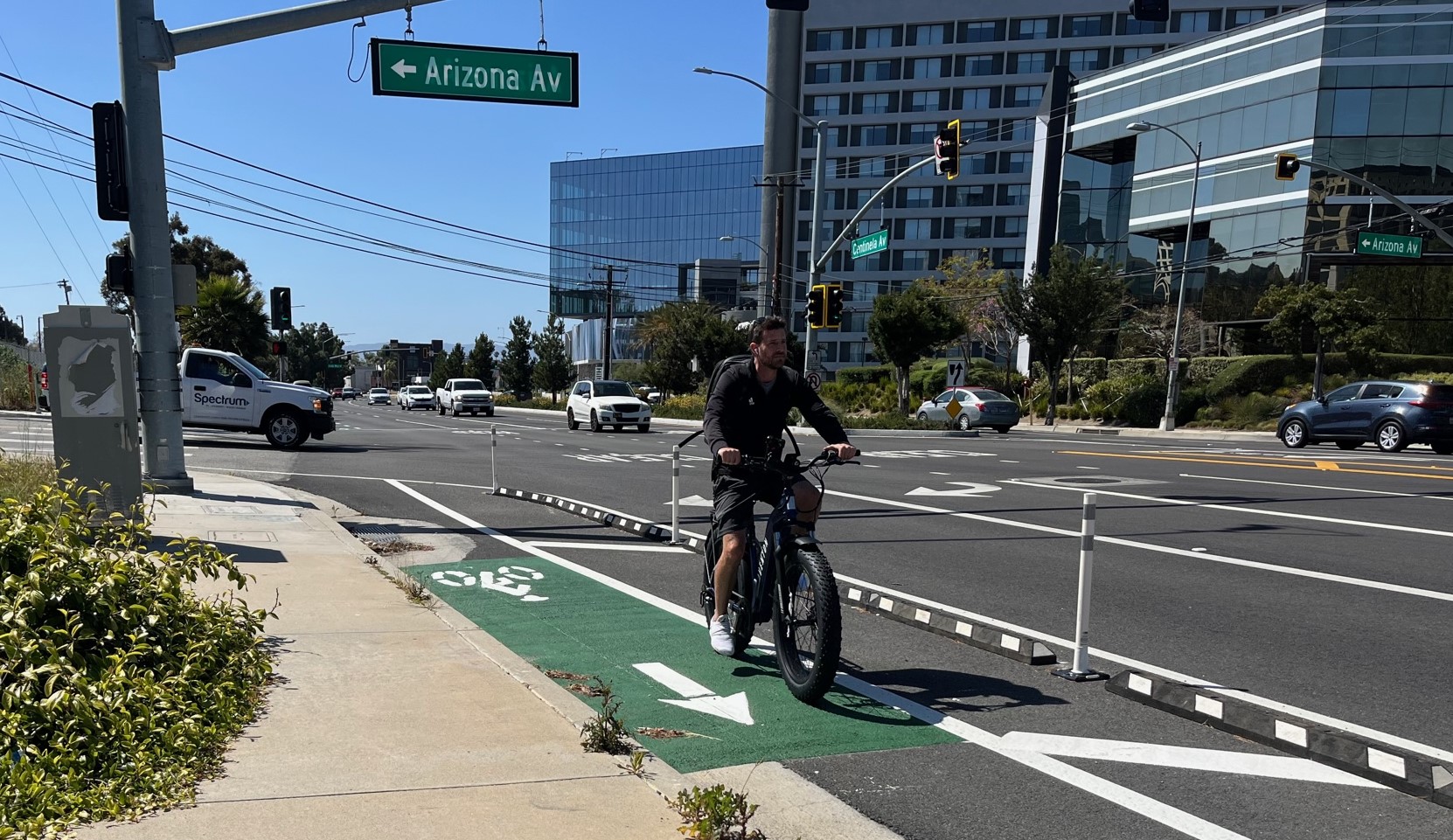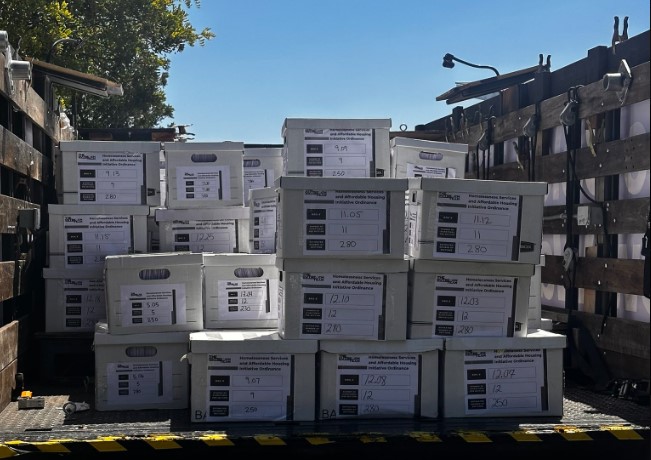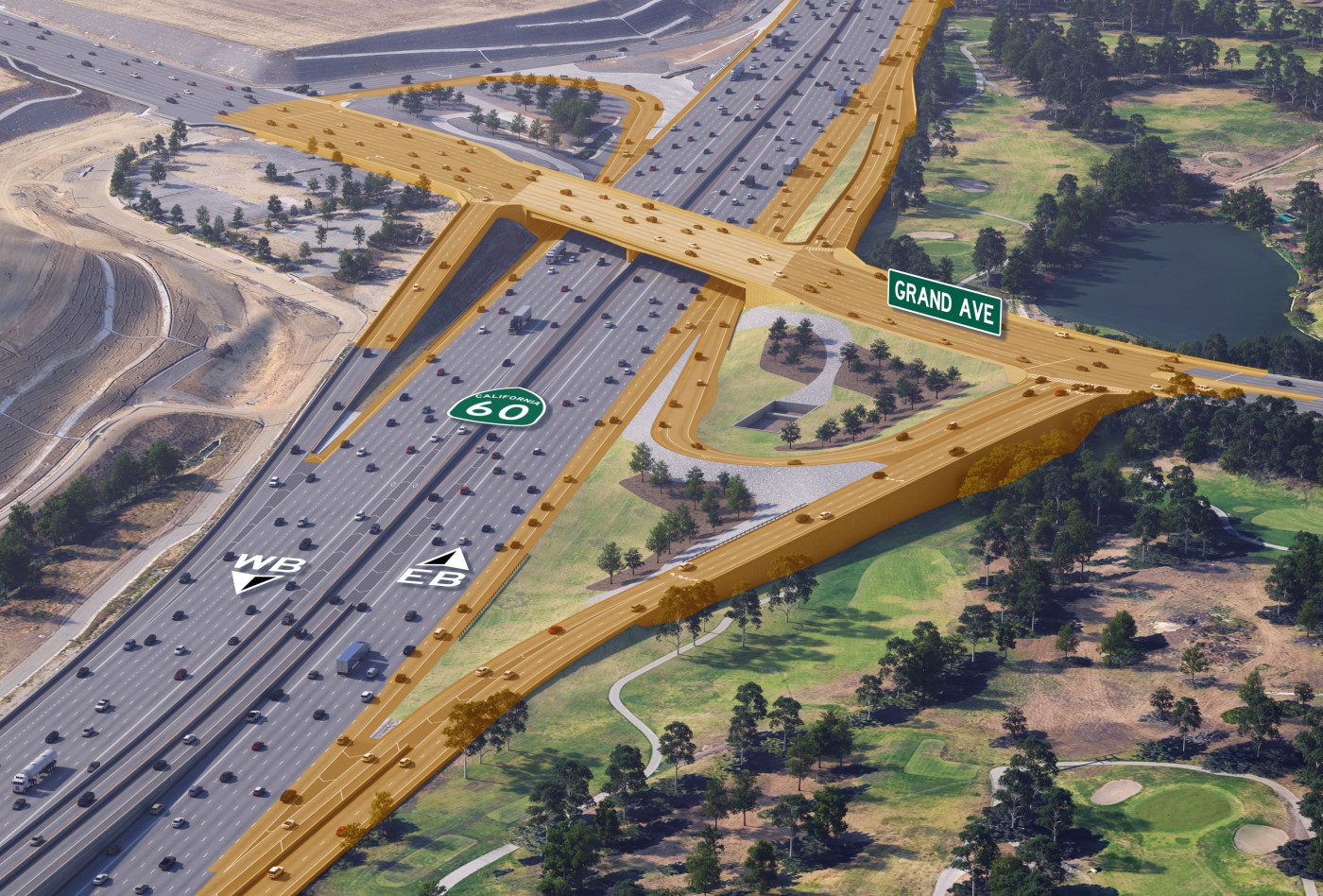Adams Boulevard Receiving Safety Upgrades, Including Bike Lanes
4:44 PM PST on December 22, 2021
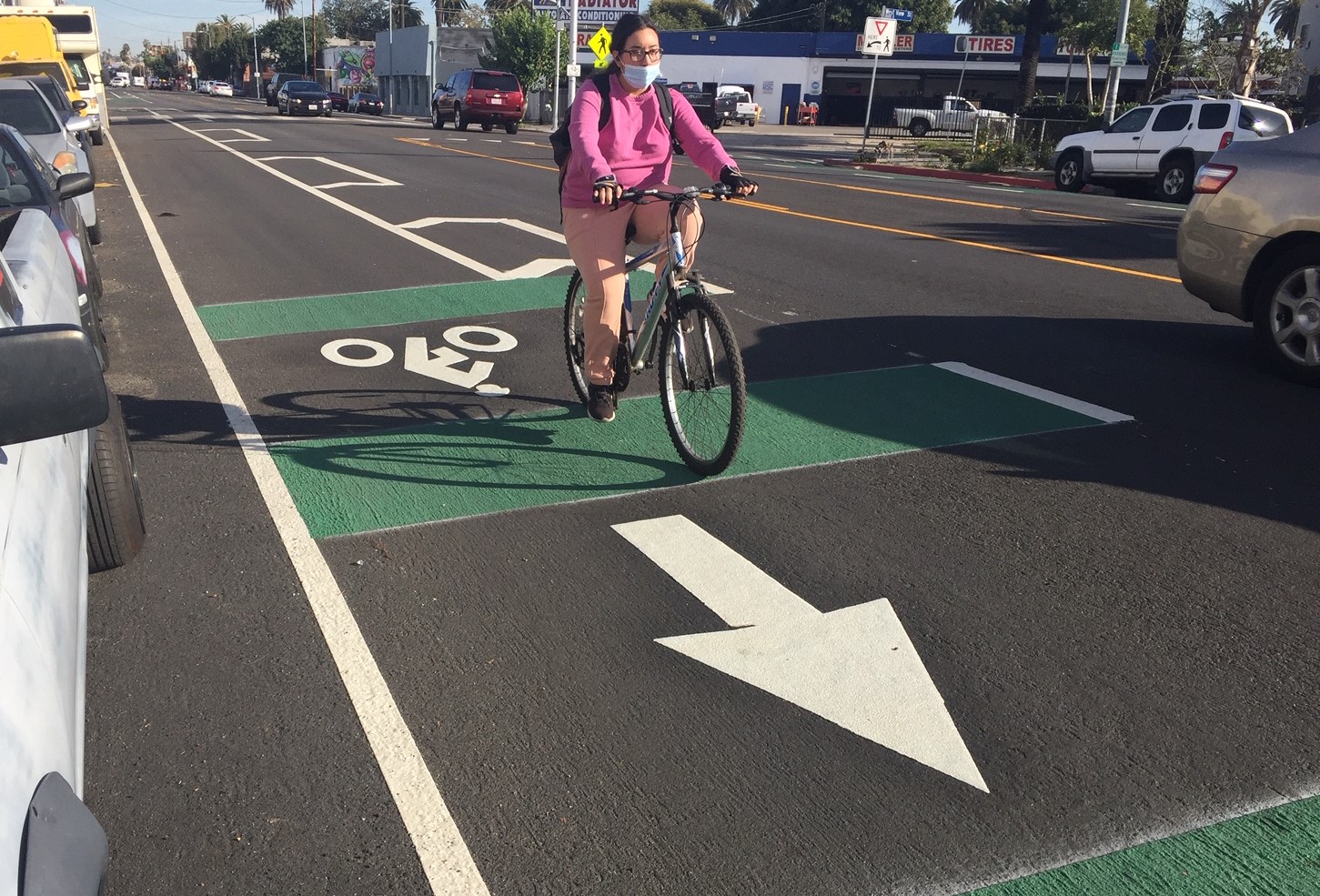
The Adams Boulevard Safety Project includes new bike lanes.
The L.A. City Transportation Department (LADOT) is making several improvements to South Los Angeles' Adams Boulevard to improve safety. Extending two miles between Crenshaw Boulevard and Fairfax Avenue, much of the Adams Boulevard Safety Project has already been completed, with a few more features to be added shortly.
Adams improvements are part of the city's Vision Zero initiative, which targets eliminating all traffic deaths by 2035. The area, currently without a city councilmember, is represented by Tenth District Caretaker Karly Katona, who wrote, "Data clearly reflected that Adams Blvd. is a high-injury and high-fatality corridor in the Tenth District and the city at-large - significantly impacting people of color - and that safety improvements were necessary."
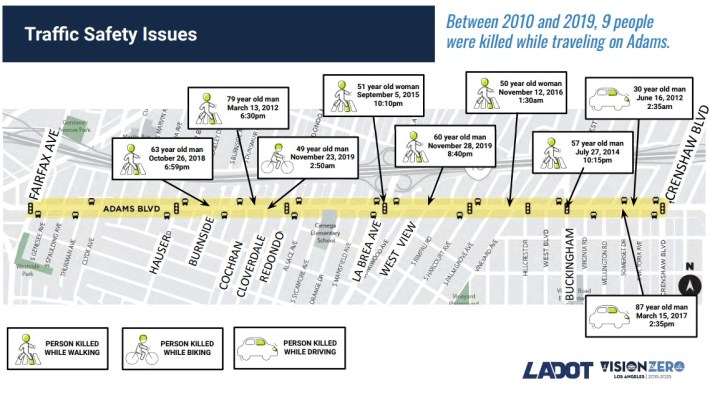
This stretch of Adams, according to LADOT, saw 59 severe and fatal collisions between 2009 and 2019. From 2012 through 2019, nine people were killed in car crashes there: six pedestrians, a cyclist, and two people in cars. LADOT spokesperson Colin Sweeney stated that Adams has "one of the highest rates of traffic fatalities and severe injuries in the City of Los Angeles."
All traffic deaths are tragic, but Adams had seen more than its share of really awful incidents.
On November 28, 2019, at Adams and West View Street, three hit-and-run drivers crashed into Jihad Muhammad, age 62. The third driver carried Muhammad's dying body 13 blocks before leaving him at a gas station on Crenshaw, then fled the scene.
Five days earlier, at Adams and Cloverdale Avenue, a drunk driver ended the life of a cyclist, apparently José Guzmán, age 49. The driver went on to crash into a parked car, and was booked on DUI charges.
In the early morning hours of November 12, 2016, at Adams and Vineyard Avenue, a hit-and-run driver struck and killed Iris Davis, age 50, as she walked across the street.
With crash data indicating that Adams safety improvements were urgently needed, Sweeney relates that LADOT began outreach in 2017. Council District 10's Katona stated that, "Our office worked in conjunction with LADOT and community members on a series of briefings to community stakeholders, including schools, churches, and residents, to explain the rationale behind making changes and solicit feedback."
One of the key community members leading the charge to improve safety was, and still is, Community Organizer and Mobility Justice Strategist Yolanda Davis-Overstreet. Davis-Overstreet founded Ride In Living Color, and serves as the Vice President of the West Adams Neighborhood Council. Both organizations were active in the outreach and design processes that shaped the Adams project.
Davis-Overstreet notes that she worked closely with LADOT's Vision Zero Supervising Transportation Planner Lauren Ballard, delivering many presentations to community groups, and incorporating community feedback into the plans.
One successful high-profile outreach event was Walk The Blvd, which took place June 26, 2021. Davis-Overstreet secured a Southern California Association of Governments (SCAG) Go Human grant to partner with CD10, WANC, and LADOT to bring West Adams folks together on-the-street to learn about and give input on proposed improvements.
Katona praised the Walk the Boulevard event for ensuring "community members understood the design, scope and experience that would be created by the improvements."
"We received positive feedback and appreciate LADOT’s efforts to design and implement street improvements that enhance safety for all users,” she said.
Davis-Overstreet credits many stakeholders for making the improvements happen, among them she includes City Council District Southwest Area District Director Kimani Black, Mayor Garcetti's office, Streets for All's Michael Schneider, and Move L.A.'s Eli Lipmen.
The Adams Boulevard Safety Project extends two miles from Crenshaw Boulevard to Fairfax Avenue. At Fairfax, the western boundary of the project area is the border between Culver City and the city of Los Angeles.
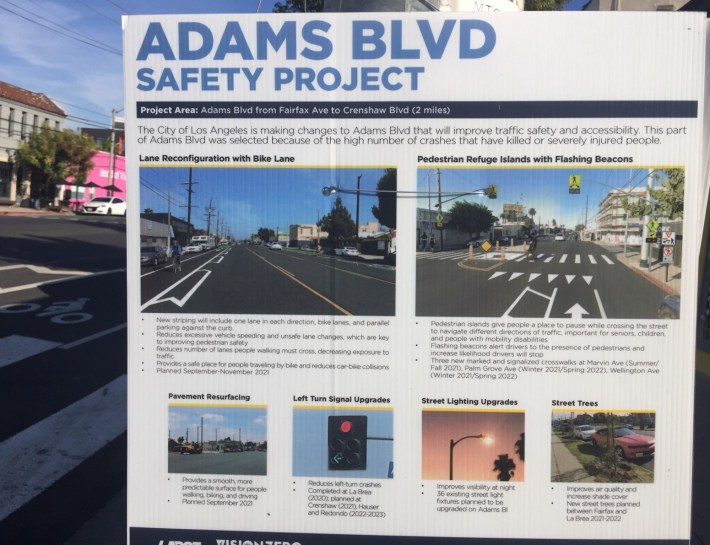
The street improvements are mostly complete. The street has been newly resurfaced and striped with two miles of new buffered bike lanes - created by reallocating space from one travel lane in each direction - called a road diet. Two miles of road diet make this one of the longest road reconfigurations implemented by LADOT in recent years. Other improvements include new flashing beacon crosswalks with pedestrian refuge islands, left turn signals, upgraded street lighting, and new street trees.
LADOT is behind the street reconfiguration changes, but the city's Bureau of Street Services (Streets L.A.) and Bureau of Sanitation are also implementing aspects of the overall safety project.
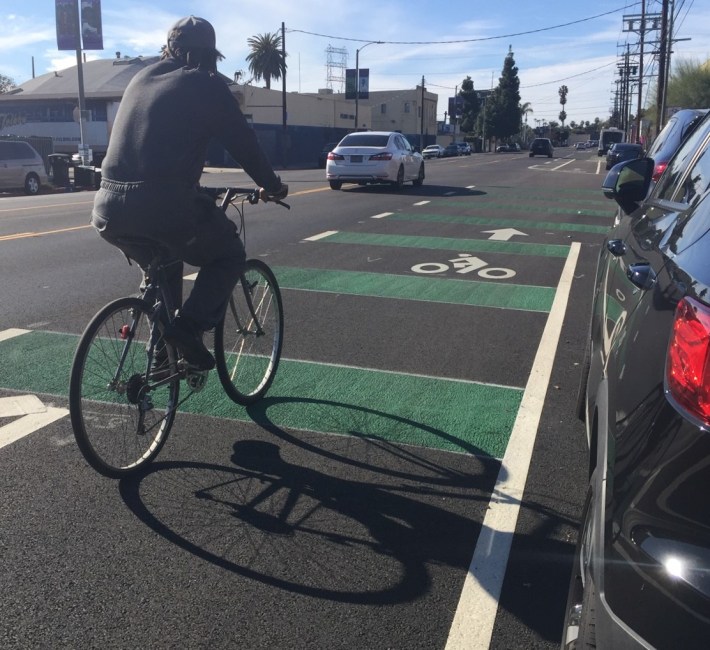
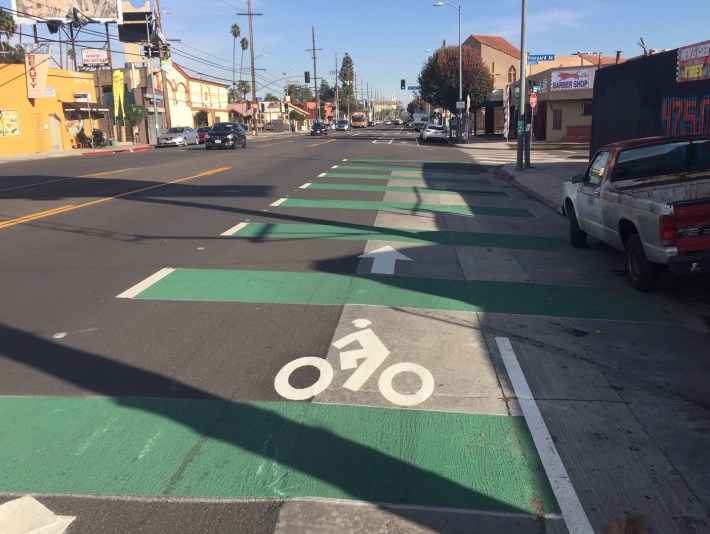
The resurfacing and new bikeway were completed in late September through mid-November. Tree planting finished last week.
More is to come: two new crosswalks/islands are due to be completed in Spring 2022 - at Palm Grove Avenue and at Wellington Road. Another, at Thurman Avenue, is scheduled to be installed in 2023-2024. In the next two years, additional left turn signals are coming to Hauser and Redondo Boulevards.

Though the street improvements are slowing down drivers and supporting bicycling and walking, they come at a precarious time for the West Adams neighborhood.
Historically, Adams Boulevard, in the project area and to the east of it, has been one of the more important commercial corridors and sites of worship for L.A.'s Black community. Running parallel to the 10 Freeway, Adams also offers a window into the community that construction of the 10 worked to undermine and physically segregate from white L.A.
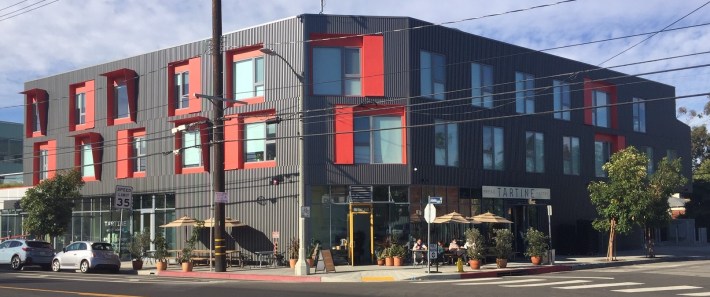
Residential and commercial rents along West Adams have been on the rise for some time, but the larger housing shortage, coupled with this area's proximity to the Westside, have accelerated gentrification.
Westside spill-over is most notable west of La Brea Avenue, closer to wealthier, whiter Culver City. Adams' low-rise commercial strip is seeing quite a bit of development - much of it mixed-use housing above shops. Commercial uses serving the lower-income Black and brown population are giving way to more upscale uses - artisanal bakeries to boutique shops to "creative office spaces." While some of the changes are welcomed by wealthier South L.A. residents that have long clamored for nearby dining and shopping options that respected their dollars, the squeeze on the lower-income residents has intensified. Especially with the influx of new housing - both on blighted vacant lots and replacing existing homes with pricier units - that is making way for a newer, wealthier population to remold the landscape.
Given that West Adams had lagged behind with regard to investments in infrastructure for so long, the arrival of the street project can add to the stress some feel about changes in the area. Do new bike lanes serve existing working-class cyclists, or are they meant to serve wealthier cyclists who are new to the neighborhood? Can they serve both of those groups and maybe many more?
Davis-Overstreet notes that the improvements are "unfamiliar to some [and] confusing to some because they are not connecting this change with safety but rather gentrification or arrogant bicyclists." She says that continued education, engagement, storytelling, sharing, healing, and community modeling are still needed. And that she will be continuing to make those happen in early 2022.
Adams finds itself needing to strike a difficult balance. How to solve high levels of traffic dangers - adversely impacting current residents - and how to do this while ensuring those residents can continue to live and shop there.
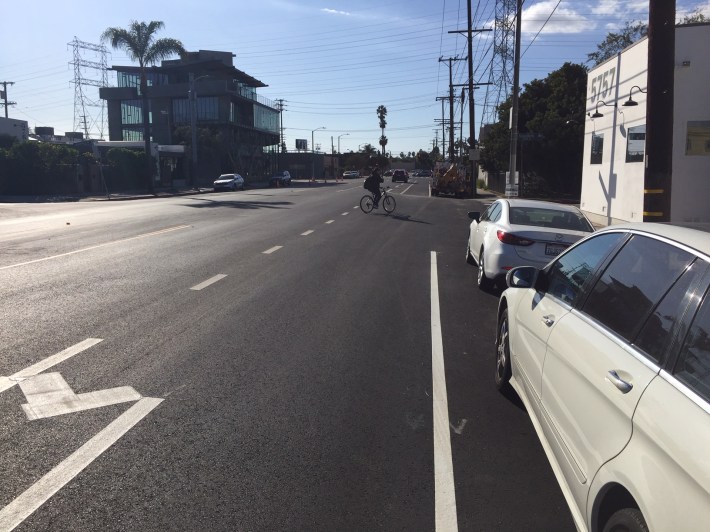
Streetsblog bicycled Adams in October (when bike lanes had been partially installed) and again a few times in December.
Though there are certainly cyclists there, relatively few are using the new bike lanes. Many, especially low-income people of color, continue to ride on the sidewalk.
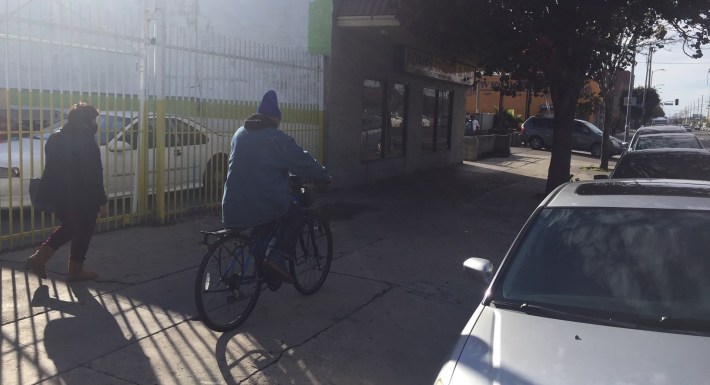
There are many issues that contribute to cyclists not using new bike lanes, more generally.
For decades, streets like Adams have been relatively dangerous, forcing cyclists onto the sidewalk. As Streetsblog has previously reported, many working-class cyclists in South L.A. also don't feel that they will be safe riding in painted bike lanes. Others don't trust drivers, some of whom are currently (dangerously and illegally) using the Adams bike lanes to cut around backed-up traffic. So many locals will bicycle facing traffic in order to be able to see who is coming at them - whether it be an inattentive driver, law enforcement, or someone who means to do them harm. Depending on the neighborhood, some young men may see new lanes as off limits altogether because they can't move through particular areas.
The fact that bike lanes have tended to arrive in tandem with a new population and before other long-standing community safety demands have been addressed, means some residents don't see bike lanes as serving them - even when the lane is outside their front door. Some rightly fear that lanes will either do little to deter police from harassing cyclists of color or will invite even greater scrutiny. For example, the County Sheriff's Department continues to claim they stopped Dijon Kizzee - the 29-year-old cyclist killed by deputies when he fled a pretextual stop in August of 2020 - for a minor bike violation, even though the streets in that neighborhood had just been upgraded explicitly to encourage biking.
Addressing the larger matrix of issues affecting street safety is key to ensuring the lanes can serve and be enjoyed by all.
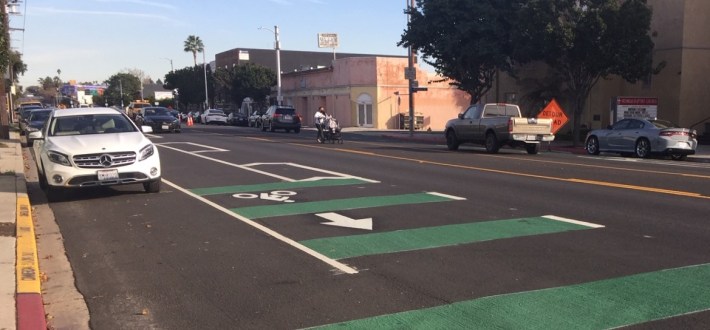
Many low-income locals still get around West Adams on foot and via bus. While the project has slowed some drivers and provided more visible space for bicycling, those primary modes haven't yet seen big changes.
Last week, Streetsblog observed a woman struggling to cross Adams Boulevard at Wellington Road - a currently unsignalized intersection where LADOT will soon be installing a flashing-beacon crosswalk. The woman, with a baby carriage, stepped out in the new bike lanes, but waited for around a minute while drivers sped past her. She then leapfrogged into the center turn lane, again waiting for a long time before a gap in traffic allowed her to make it across the remaining car lane.
Though Adams is changing - in several ways - a lot of work is still needed before current residents can safely cross the street.
Stay in touch
Sign up for our free newsletter
More from Streetsblog Los Angeles
Eyes on the Street: Recent Centinela Bike Lanes in Culver City
The new partially-protected Centinela facility is a welcome safety upgrade for a stretch that long lacked any type of bikeway, but the area remains not all that bike-friendly
This Week In Livable Streets
Bike Month continues, Metro 91 Freeway widening, Destination Crenshaw, Culver City Bus, Santa Monica MANGo, Metro bike lockers, Metro Sepulveda Transit, and more
San Fernando Valley Bus/Bike Updates: G Line, Roscoe Bus Lanes, Laurel Canyon Bike Lanes
Short newly protected bike lane on Laurel Canyon Blvd, extensive NSFV bus improvements under construction this month, and scaled-back G Line plans should get that project under construction this summer
